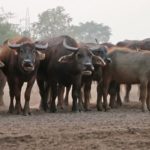Bovine: Members of the biological subfamily Bovinae. This diverse group features about 24 species of medium-sized to large animals with hoofs such as domestic cattle. Other members include bison, water buffalo and yak. (گائÛØ Ø¨Ú¾ÛÙØ³Ø Ûاک ÙغÛرÛ)
Forage: Cow feed that is high in fibre and low in digestible nutrients. Examples include whole plants of corn, small grains (such as oats, barley, or wheat), legumes and grasses. (Ù
ÙÛØ´Û Ú©Ø§ ÚارÛ)
Bullock: Young bull, typically less than 20 months of age. (بÛÙ)
Cud: Bolus of feed that cattle regurgitate for further chewing.
(جگاÙÛ)
Castrate: To remove the testicles. (Ø®ØµÛ Ú©Ø±Ùا)
Colostrum: First milk given by a female following delivery of her calf. It is high in antibodies that protects the calf from invading microorganisms.
(Ù
ÙÛØ´ÛÙÚº Ú©Û Ø²ÚÚ¯Û Ú©Û Ø¨Ø¹Ø¯ ÙÚ©ÙÙÛ ÙاÙا دÙدھ جس Ù
ÛÚº ÚØ±Ø¨Û Ú©Û Ù
Ùدار زÛØ§Ø¯Û ÛÙØªÛ ÛÛ)
Dewlap: Loose skin under the chin and neck of cattle.
(Ú¯ÙÛ Ú©Û ÙÛÚÛ ÙÙ¹Ú©ØªÛ ÛÙØ¦Û Ú©Ú¾Ø§Ù)
Ear mark: Method of permanent identification by which slits or notches are placed in the ear.
(Ù
ÙÛØ´ÛÙÚº کا Ø´ÙØ§Ø®ØªÛ ÙشاÙ)
Feed bunk: Trough or container used to feed cattle. (ÚارÛکا ٹب)
Heifer: Young female bovine cow prior to the time that she has produced her first calf. (بÚÚ¾ÚÛ)
Hides: Skins from cattle.
(Ù
ÙÛØ´ÛÙÚº کا ÚÙ
ÚÛ)
Insemination: Deposition of semen in the female reproductive tract. Masnooyi tauleedi amal.
Pasteurization: It is a simple, effective method to kill harmful pathogens through heat treatment without affecting the taste or nutritional value of milk. Since its introduction over a century ago, pasteurization has been recognized around the world as an essential tool for protecting public health. The process was named after its inventor, French scientist Louis Pasteur.
(دÙدھ Ú©Û Ø¬Ø±Ø§Ø«ÛÙ
Ú©Ù Ù
ارÙÛ Ú©Ø§ عÙ
٠جس Ù
ÛÚº اس ک٠اÙبا٠کر Ù¹Ú¾ÙÚا Ú©Ûا جاتا ÛÛ)
Pasture: Land at a dairy farm that is lush with vegetation cover such as grasses or legumes and is used for grazing dairy cows. (ÚراگاÛ)
Ruminant: Mammal whose stomach has four parts–rumen, reticulum, omasum, and abomasum. Cattle, sheep, goats, deer, and elk are ruminants.
(جگاÙÛ Ú©Ø±ÙÛ ÙاÙÛ Ø¬Ø§ÙÙر)
Rumination: Regurgitation of undigested food that is chewed and then swallowed again.
(Ù
ÙÛØ´ÛÙÚº کا ÙظاÙ
Ù ÛاضÙ
Û Ø¬Ø³ Ù
ÛÚº ÚØ§Ø±Û Ú©Ú¾Ø§ÙÛ Ú©Û Ø¨Ø¹Ø¯ Ù
ÙÛØ´Û Ø§Ø³Û Ø¯ÙØ¨Ø§Ø±Û Ù¾ÛÙ¹ Ø³Û Ùکا٠کر ÚØ¨Ø§ØªÛ ÛÛÚº)
Udder: Encased group of mammary glands of the female.
(دÙدھ Ú©Û ØªÚ¾Ù)
Weaning (wean): Separating young animals from their dams so that the offspring can no longer suckle.
(بÚÚ¾ÚÙÚº Ú©Û Ù
اں کا دÙدھ ÚÚ¾ÚاÙÛ Ú©Ø§ عÙ
Ù)
Whey: The watery part of milk that separates from the curds during the cheese-making process.
(دÛÛ Ú©Ø§ پاÙÛ ÙÙ
ا ØصÛ)
Yearling: Animals that are approximately one-year old.
(اÛÚ© برس ÙاÙÛ Ù
ÙÛØ´Û)


COMMENTS